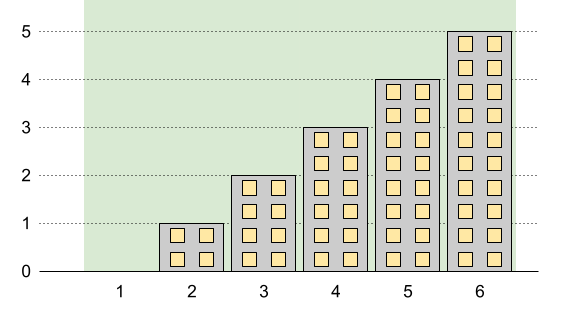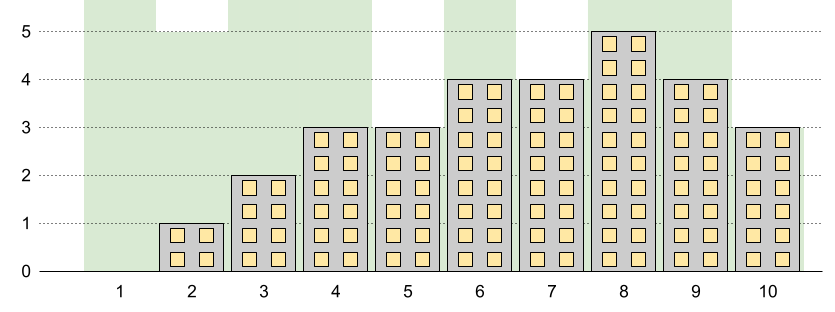You want to build n new buildings in a city. The new buildings will be built in a line and are labeled from 1 to n.
However, there are city restrictions on the heights of the new buildings:
- The height of each building must be a non-negative integer.
- The height of the first building must be
0. - The height difference between any two adjacent buildings cannot exceed
1.
Additionally, there are city restrictions on the maximum height of specific buildings. These restrictions are given as a 2D integer array restrictions where restrictions[i] = [idi, maxHeighti] indicates that building idi must have a height less than or equal to maxHeighti.
It is guaranteed that each building will appear at most once in restrictions, and building 1 will not be in restrictions.
Return the maximum possible height of the tallest building.
Example 1:
Input: n = 5, restrictions = [[2,1],[4,1]] Output: 2 Explanation: The green area in the image indicates the maximum allowed height for each building. We can build the buildings with heights [0,1,2,1,2], and the tallest building has a height of 2.
Example 2:
Input: n = 6, restrictions = [] Output: 5 Explanation: The green area in the image indicates the maximum allowed height for each building. We can build the buildings with heights [0,1,2,3,4,5], and the tallest building has a height of 5.
Example 3:
Input: n = 10, restrictions = [[5,3],[2,5],[7,4],[10,3]] Output: 5 Explanation: The green area in the image indicates the maximum allowed height for each building. We can build the buildings with heights [0,1,2,3,3,4,4,5,4,3], and the tallest building has a height of 5.
Constraints:
2 <= n <= 1090 <= restrictions.length <= min(n - 1, 105)2 <= idi <= nidiis unique.0 <= maxHeighti <= 109
Related Topics:
Binary Search, Greedy
We should remove the useless restrictions and only keep the critical ones.
Put all the restrictions into a m which is a map from the x value to the height restriction. Note that m[1] = 0 should also be added.
Scan from left to right, assume two consecutive restrictions are a = [x1, h1] and b = [x2, h2] (x1 < x2). If h2 >= h1 + x2 - x1, b is useless and should be removed.
Scan from right to left, assume two consecutive restrictions are a = [x1, h1] and b = [x2, h2] (x1 < x2). If h1 >= h2 + x2 - x1, a is useless and should be removed.
For two consecutive restrictions are a = [x1, h1] and b = [x2, h2] (x1 < x2), assume the tallest building between them is at position x, then one of the following is is true:
- When there is only one tallest building,
h1 + x - x1 == h2 + x2 - x, so2 * x = h2 - h1 + x1 + x2 - When there are two tallest buildings,
h1 + x - x1 == h2 + x2 - x - 1, so2 * x = h2 - h1 + x1 + x2 - 1.
So x = ceil( (h2 - h1 + x1 + x2) / 2 ), and the corresponding height is h1 + x - x1.
One special case is the last restriction [x, h]. The height we can get using it is h + n - x.
// OJ: https://leetcode.com/problems/maximum-building-height/
// Author: github.com/lzl124631x
// Time: O(RlogR)
// Space: O(R)
class Solution {
public:
int maxBuilding(int n, vector<vector<int>>& A) {
map<long, long> m{{1,0}};
for (auto &v : A) m[v[0]] = v[1];
long ans = 0;
for (auto it = next(begin(m)); it != end(m);) {
auto [x1, h1] = *prev(it);
auto [x2, h2] = *it;
if (h2 >= h1 + x2 - x1) {
it = m.erase(it);
} else {
it = next(it);
}
}
for (auto it = prev(end(m)); it != begin(m);) {
auto [x1, h1] = *prev(it);
auto [x2, h2] = *it;
if (h1 >= h2 + x2 - x1) {
m.erase(prev(it));
} else {
it = prev(it);
}
}
for (auto it = next(begin(m)); it != end(m); ++it) {
auto [x1, h1] = *prev(it);
auto [x2, h2] = *it;
long x = (h2 - h1 + x1 + x2) / 2;
ans = max(ans, h1 + x - x1);
}
auto [x, h] = *rbegin(m);
ans = max(ans, h + n - x);
return ans;
}
};// OJ: https://leetcode.com/problems/maximum-building-height/
// Author: github.com/lzl124631x
// Time: O(RlogR)
// Space: O(1)
// Ref: https://leetcode.com/problems/maximum-building-height/discuss/1175047/PythonC%2B%2B-greedy-solution-with-visual-explanation-O(MlogM)
class Solution {
public:
int maxBuilding(int n, vector<vector<int>>& A) {
A.push_back({1, 0});
sort(begin(A), end(A));
int N = A.size(), ans = 0;
for (int i = 1; i < N; ++i) {
int x1 = A[i - 1][0], h1 = A[i - 1][1];
int x2 = A[i][0], &h2 = A[i][1];
h2 = min(h2, h1 + x2 - x1);
}
for (int i = N - 2; i >= 0; --i) {
int x1 = A[i][0], &h1 = A[i][1];
int x2 = A[i + 1][0], h2 = A[i + 1][1];
h1 = min(h1, h2 + x2 - x1);
int mid = (h2 - h1 + x1 + x2) / 2;
ans = max(ans, h1 + mid - x1);
}
return max(ans, A.back()[1] + n - A.back()[0]);
}
};

